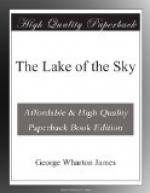“The andesite volcanoes were mainly located along the crest of the Sierra, in fact, almost continuously from Thompson Peak, west of Honey Lake, down to latitude 38 deg. degrees 10’. Farther south the eruptions diminished greatly in intensity.... Along the first summit of the range west of Tahoe the greatest number of vents are found. Beginning at Webber Lake on the north, they include Mount Lola, Castle Peak, Mount Lincoln, Tinker Knob, Mount Mildred and Twin Peak. The andesite masses here in places attain a thickness of 2000 feet. An interval followed in the northern part of the Pyramid Peak quadrangle where no important volcanoes were located, but they appear again in full force in Alpine County. Round Top, attaining an elevation of 10,430 feet, and the adjacent peaks, were the sources of the enormous flows which covered a large part of Eldorado County. Still another volcanic complex with many eruptive vents is that situated in the western part of Alpine County, near Markleeville, which culminates in Highland Peak and Raymond Peak, the former almost reaching 11,000 feet. The total thickness of the volcanic flows in this locality is as much as 4000 feet.”
It is to these breccias we owe the volcanic appearances in the Truckee River Canyon, a few miles before reaching the Lake. There are several layers of the andesites breccias at the head of Bear Creek Canyon, above Deer Park Springs.
“None of the craters,” says Lindgren, “of these volcanoes are preserved, and at the time of their greatest activity they may have reached a height of several thousand feet above the present summits.”
CHAPTER VIII
THE GLACIAL HISTORY OF LAKE TAHOE
We have already seen in the preceding chapter how the great basin, in which Lake Tahoe rests, was turned out in the rough from Nature’s workshop. It must now be smoothed down, its angularities removed, its sharpest features eliminated, and soft and fertile banks prepared upon which trees, shrubs, plants and flowers might spring forth to give beauty to an otherwise naked and barren scene.
It is almost impossible for one to picture the Tahoe basin at this time. There may have been water in it, or there may not. All the great mountain peaks, most of them, perhaps, much higher by several thousands of feet than at present, were rude, rough, jagged masses, fresh from the factory of God. There was not a tree, not a shrub, not a flower, not a blade of grass. No bird sang its cheering song, or delighted the eye with its gorgeous plumage; not even a frog croaked, a cicada rattled, or a serpent hissed. All was barren desolation, fearful silence and ghastly newness.
What were the forces that produced so marvelous a change?
Snowflakes,—“flowers of the air",—as John Muir so poetically calls them. They accomplished the work. Falling alone they could have done nothing, but coming down in vast numbers, day after day, they piled up and became a power. Snow forms glaciers, and glaciers are mighty forces that create things.




